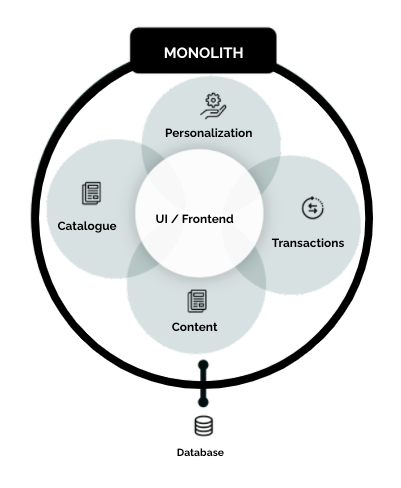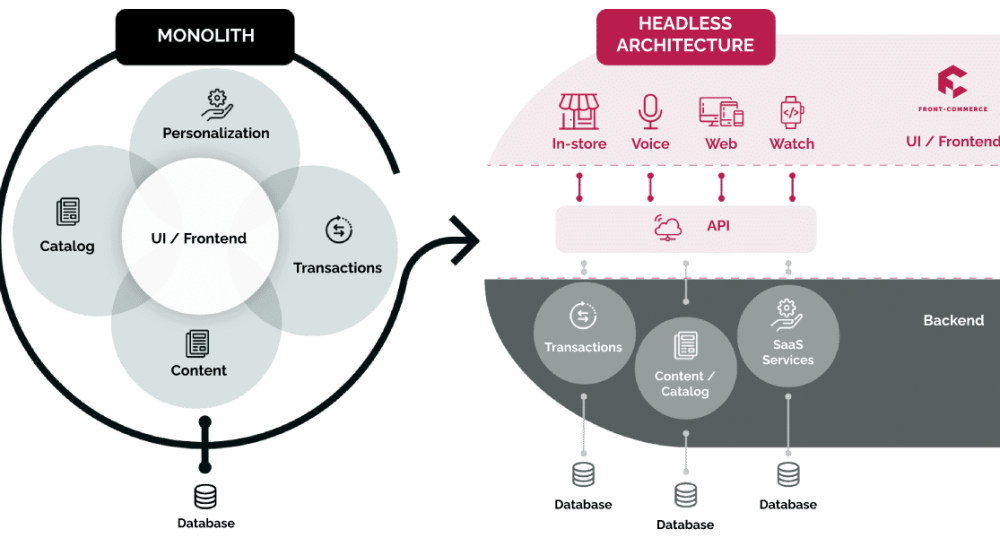Take Your Magento Store into the Future with a Headless Approach
According to researchers, the most popular website architecture for B2B and B2C firms will be based on headless commerce from now and into the future.
Research shows Magento covers 20% of all eCommerce shops, making it one of the most popular eCommerce systems available. And although it is one of the market leaders, traditional e-commerce platform Magento has its limitations.
If you are already using Magento 1 or 2 for your e-commerce store, now is the time to consider taking it into the future with a Headless approach. Read on to learn the advantages of a headless architecture for your business and how to get started.
Magento – A Monolithic Platform
Magento is one of the most popular online store platforms, with over 250.000 active stores, including major brands like Nike and Samsung. Adobe bought Magento in 2018 for $1.68B and has since started rebranding the platform under the name Adobe Commerce.
If you are new to e-commerce, Magento is a platform worth considering. Find out why.
If Magento is already your platform of choice, you’ll have noticed its tightly connected back-end and front-end create issues when you need to evolve your website. Each element of your platform is dependent on the other, making it difficult and slow or impossible to make changes.

Whether that change be to your UX, the need to develop a new feature, any evolution in one area will mean redeploying all others. Improving your web performance with new or modern technologies is also complicated.
The Headless Revolution
The term “Headless” or “Composable” commerce is popping up more and more. It’s a big innovation and can seem less straightforward than it really is. Headless commerce is, essentially, a separation between the front-end and back-end of an e-commerce platform. You are no longer limited by the features of a monolithic solution like with the traditional Magento setup.
Why is a headless e-commerce architecture useful?
A headless architecture consists of one or more systems that are used to store content and deliver it through APIs. Unlike the traditional approach, there is no store theme or template designed for your users: the “head” has been cut off. This leaves merchants able to personalize their front-end user experience with an on-brand UX that’s best in class.
Headless commerce allows you to combine content and data from several different sources, also known as microservices, leaving it possible to create the platform that best suits your business needs.

With a headless Magento, eCommerce site owners may select from various solution providers instead of being limited to a single vendor. This gives a lot of flexibility in terms of choosing software & applications such as CMS, OMS, PIM … opening up the possibility of creating a best-of-breed MACH stack.
What are the business advantages?
So we’ve spoken a little about the technical advantages of a headless commerce architecture, but what about the positive effects it can have on your business performance? The technical advantages will have a direct positive impact on business KPIs such as your conversion rate, ROI, customer retention and loyalty and SEO ranking and revenue. Devialet, for example, doubled their mobile conversion rate following the implementation of a headless Magento with the Front-Commerce front-end.
How to move to a Headless Magento
Because of its unrivalled collection of sophisticated APIs, ease of use on the back-end, and rapid time to market, Magento Commerce is ideal for headless eCommerce.
The Front-Commerce front-end is designed to connect seamlessly to & communicate with your Magento backend via a secure API to display your content easily across devices.
Both the front and back end are self-contained and can be developed separately, as well as hosted on separate servers. This makes it easier to evolve your UX, features and integrations as time goes on, without affecting each area of your platform when you implement the changes. Your time to market will increase tenfold.
Setting the new standard in eCommerce
The Front-Commerce team will decouple your existing Magento frontend from the backend for you. We’ll implement a storefront using React, Apollo, Webpack, Storybook, etc. that will allow you to create a user experience that’s on brand and responds to your customers’ needs. You’ll have greater freedom to present information in the way you desire (without being forced to do it the Magento way).
Our front-end is PWA powered making your online store faster on the web and mobile responsive. It has the capability to behave like a native application on mobile devices & tablets and can even work offline.
“We value Front-Commerce as a partner as it’s the best headless front-end out there for Magento 1 and 2.” – Frédéric Martinez, PH2M
We add a GraphQL layer to enable you to leverage data via any API source easily (CMS, eCommerce Platform, PIM, ERP…). By interweaving your data sources into a streamlined flow, you will be able to make reliable business decisions, faster.
We provide all the tools needed for maintaining a deployed website: an extensive logging system (client / server errors), error boundaries, maintenance mode, SEO, internationalization, security, caching and invalidation, payments, image processing, etc.
Not ready to move from M1 to M2?
We’ve made it possible for you to go headless but migrate progressively, in your own time. The diagram below shows an example of a progressive migration timeline that can be adapted to your particular case.
Conclusion
A headless PWA frontend for Magento commerce is the logical next step for your e-commerce platform. Blending modern technologies with a headless e-commerce architecture will take your website into the future, making it possible for you to reach new business goals – fast.
